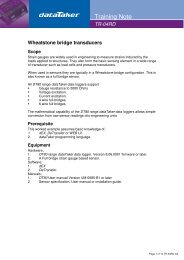Create successful ePaper yourself
Turn your PDF publications into a flip-book with our unique Google optimized e-Paper software.
Notes and Examples<br />
Extracting and Formatting Bit Fields<br />
In the following example two 16-bit fields plus four 4-bit fields are packed into the CAN message with identifier 0x118. The<br />
most recent value for each of these fields will be returned when polled by the host.<br />
CONNECT 1 500 'Enable CAN port 1 at 500kbps<br />
BEGIN<br />
12 RECV 1 0x118 1 2 FORMAT "P1:%d\n"<br />
13 RECV 1 0x118 3 4<br />
14 RECV 1 0x118 5.8 5.5<br />
15 RECV 1 0x118 5.4 5.1 FORMAT 10 -40<br />
16 RECV 1 0x118 6.8 6.5 FORMAT .25 "Gibble Freq. %6.3f Hz\n"<br />
17 RECV 1 0x118 6.4 6.1<br />
END<br />
So if the last message that <strong>CANgate</strong> received (with CAN ID 0x118) happened to have the following 64-bit data field:<br />
019266401A9F0000<br />
and the above six memory slots were polled, for example using the command:<br />
RP 12 17<br />
then the following data would be returned:<br />
P1:402 (bytes 1-2 = 0x0192 = 402)<br />
6640 (bytes 3-4 = 0x6640)<br />
01 (byte 5 = 0x1A, bits 8-5 = 0x1)<br />
60.00 (byte 5 = 0x1A, bits 4-1 = 0xA, scaled by 10 with offset -40 = 60)<br />
Gibble Freq. 2.250 Hz (byte 6 = 0x9F, bits 8-5 = 0x9, scaled by 0.25 = 2.25)<br />
0F<br />
(byte 6 = 0x9F, bits 4-1 = 0xF)<br />
In this case three of the memory slots use the FORMAT specifier to return their values in scaled engineering units, rather than<br />
raw hexadecimal. Slot #15 uses the default format string of "%f\n", ie. floating point, 2 decimal places, followed by CRLF.<br />
J1939 PGNs & SPNs<br />
Broadcast PGNs<br />
J1939 based systems typically have a multitude of SPNs (Suspect Parameter Numbers), each representing an individual<br />
measured quantity or status. A group of related SPNs will be broadcast over the CAN network under a particular Parameter<br />
Group Number (PGN), which is specified as part of the 29 bit identifier.<br />
Each 29 bit identifier carries with it one 64 bit packet of CAN data. Some PGNs with a data length larger the 64 bits require<br />
several packets to send them. <strong>CANgate</strong> automatically uses the J1939 transport protocol to send or receive large PGNs.<br />
Refer to RQSTJ – Request J1939 Data (P20) or the SAE J1939/21 (Data Link Layer) standard for a more detailed description<br />
on PGN numbers and how they are encoded into CAN identifiers.<br />
An example of a J1939 SPN would be “Engine Speed”. In order to capture engine speed using <strong>CANgate</strong>, it is first necessary<br />
to determine the PGN which contains this parameter. This can be found in SAE J1939/71 (Vehicle Application Layer), which<br />
specifies:<br />
Electronic Engine Controller #1<br />
Update rate: Engine speed dependent<br />
Data length: 8 bytes<br />
Data page: 0<br />
PDU format: 240<br />
PDU specific: 4<br />
Default priority 3<br />
Parameter Group Number: 61,444 (0x00F004)<br />
Byte: 1 Status_EEC1<br />
Bit: 8-5 Not defined<br />
Bit: 4-1 Engine/retarder torque mode<br />
Byte: 2 Driver’s demand engine – percent torque<br />
Byte: 3 Actual engine – percent torque<br />
Byte: 4-5 Engine Speed<br />
Byte: 6-8 Not defined<br />
The precise format of each SPN is also specified in SAE J1939/71:<br />
Engine Speed<br />
Data Length: 2 bytes<br />
Resolution: 0.125 rpm/bit gain, 0 rpm offset<br />
UM-0086-A2 <strong>CANgate</strong> User’s <strong>Manual</strong> Page 28



